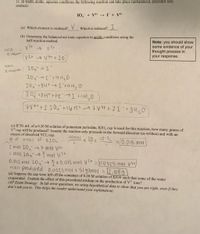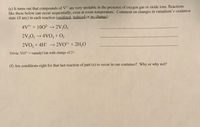
Chemistry
10th Edition
ISBN: 9781305957404
Author: Steven S. Zumdahl, Susan A. Zumdahl, Donald J. DeCoste
Publisher: Cengage Learning
expand_more
expand_more
format_list_bulleted
Concept explainers
Question
How do I finish this problem? I’ve done a,b, and c.

Transcribed Image Text:11. In warm, acidic, aqueous conditions the following reaction can take place (unbalanced, spectator ions
omitted):
I0,- + V³+ → F + Vš+
(a) Which element is oxidized?
Which is reduced? I
(b) Determine the balanced net ionic equation in acidic conditions using the
half-reaction method.
Note: you should show
some evidence of your
thought process in
V 3+
Ovid.
Y2 reaurion.
V3t VSt + 2 e/
your response.
educ.
2 reaction: IOy
1041+4 H20
IOu +8H+ -> I +4420
10+8H*+7e→ I'+4H,0
7V3*+2 I Oy +I6H+)7 VSt+ 2 I + 8H20
(c) If 50. mL of a 0.30 M solution of potassium periodate, KIO, (aq) is used for this reaction, how many grams of
V* (aq) will be produced? Assume the reaction only proceeds in the forward direction (as written) and with an
excess of dissolved VCl, (aq).
# of moes of KIO4
.30mol
10.015mol
2 mol I0,7 moj Vst
I mol 104- mol Vt
0.01S mol 104 x0.015 mol Vot =0.0525 mol Vst
Mass produced 0.052s mol x 5/91mol = 2.089
(d) Suppose the cap were left off the container of 0.30 M solution of KIO4 such that some of the water
evaporated. Explain the effect of this procedural mishap on the production of V* ions?
(AP Exam Strategy: In lab error questions, try using hypothetical data to show that you are right, even if they
don't ask you to. This helps the reader understand your explanation)
%3D

Transcribed Image Text:(e) It turns out that compounds of V" are very unstable in the presence of oxygen gas or oxide ions. Reactions
like these below can occur sequentially, even at room temperature. Comment on changes in vanadium's oxidation
state (if any) in each reaction (oxidized, reduced or no change)
4V$+ + 1002 → 2V,O5
2V,0, → 4VO, + O,
2VO, + 4H*
2VO2* + 2H,0
Trivia: VO2* = vanadyl ion with charge of 2+.
(f) Are conditions right for that last reaction of part (e) to occur in our container? Why or why not?
Expert Solution
This question has been solved!
Explore an expertly crafted, step-by-step solution for a thorough understanding of key concepts.
Step by stepSolved in 4 steps with 1 images

Knowledge Booster
Learn more about
Need a deep-dive on the concept behind this application? Look no further. Learn more about this topic, chemistry and related others by exploring similar questions and additional content below.Similar questions
- Circle the strongest base below. BOX the WEAKEST base shown. a) b) c) d) e) f) Nao NaOČCH3 NaC=CCH3 NaOCH,CH3 NaBr NaOHarrow_forwardgive a 5 letter answer in orderarrow_forward8. Rank the following in order of most basic (1) to least basic (4)? Explain the reasoning for your answer. H,C=CH HCECO H3C- -CH,O H3Carrow_forward
- 1. Identify each move below as attack, leave, protonate (or deprotonate), or rearrang e. A. B. н- но- O-H н.8н н,о° +] D.[ E. F.arrow_forwardRank the following compounds in order of decreasing basicity, putting the most basic compound first. NH₂ A. || > | > ||| > IV B. | > | > ||| > IV C. | > ||| > | > IV D. IV> | > ||| > | NH₂ Br III NH₂ F3C IV NH₂arrow_forwarda. 5. Draw the product(s) of each addition reaction b. d. دھ HBr H2SO4, H₂O Bra, H2O a. 9-BBN b. H2O2, NaOHarrow_forward
arrow_back_ios
SEE MORE QUESTIONS
arrow_forward_ios
Recommended textbooks for you
 ChemistryChemistryISBN:9781305957404Author:Steven S. Zumdahl, Susan A. Zumdahl, Donald J. DeCostePublisher:Cengage Learning
ChemistryChemistryISBN:9781305957404Author:Steven S. Zumdahl, Susan A. Zumdahl, Donald J. DeCostePublisher:Cengage Learning ChemistryChemistryISBN:9781259911156Author:Raymond Chang Dr., Jason Overby ProfessorPublisher:McGraw-Hill Education
ChemistryChemistryISBN:9781259911156Author:Raymond Chang Dr., Jason Overby ProfessorPublisher:McGraw-Hill Education Principles of Instrumental AnalysisChemistryISBN:9781305577213Author:Douglas A. Skoog, F. James Holler, Stanley R. CrouchPublisher:Cengage Learning
Principles of Instrumental AnalysisChemistryISBN:9781305577213Author:Douglas A. Skoog, F. James Holler, Stanley R. CrouchPublisher:Cengage Learning Organic ChemistryChemistryISBN:9780078021558Author:Janice Gorzynski Smith Dr.Publisher:McGraw-Hill Education
Organic ChemistryChemistryISBN:9780078021558Author:Janice Gorzynski Smith Dr.Publisher:McGraw-Hill Education Chemistry: Principles and ReactionsChemistryISBN:9781305079373Author:William L. Masterton, Cecile N. HurleyPublisher:Cengage Learning
Chemistry: Principles and ReactionsChemistryISBN:9781305079373Author:William L. Masterton, Cecile N. HurleyPublisher:Cengage Learning Elementary Principles of Chemical Processes, Bind...ChemistryISBN:9781118431221Author:Richard M. Felder, Ronald W. Rousseau, Lisa G. BullardPublisher:WILEY
Elementary Principles of Chemical Processes, Bind...ChemistryISBN:9781118431221Author:Richard M. Felder, Ronald W. Rousseau, Lisa G. BullardPublisher:WILEY

Chemistry
Chemistry
ISBN:9781305957404
Author:Steven S. Zumdahl, Susan A. Zumdahl, Donald J. DeCoste
Publisher:Cengage Learning

Chemistry
Chemistry
ISBN:9781259911156
Author:Raymond Chang Dr., Jason Overby Professor
Publisher:McGraw-Hill Education

Principles of Instrumental Analysis
Chemistry
ISBN:9781305577213
Author:Douglas A. Skoog, F. James Holler, Stanley R. Crouch
Publisher:Cengage Learning

Organic Chemistry
Chemistry
ISBN:9780078021558
Author:Janice Gorzynski Smith Dr.
Publisher:McGraw-Hill Education

Chemistry: Principles and Reactions
Chemistry
ISBN:9781305079373
Author:William L. Masterton, Cecile N. Hurley
Publisher:Cengage Learning

Elementary Principles of Chemical Processes, Bind...
Chemistry
ISBN:9781118431221
Author:Richard M. Felder, Ronald W. Rousseau, Lisa G. Bullard
Publisher:WILEY